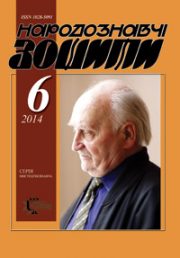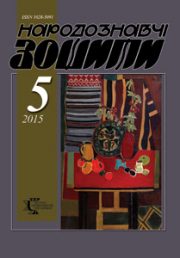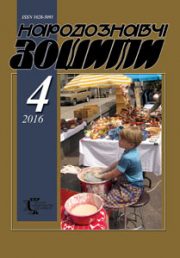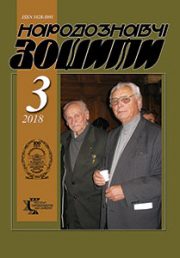The Ethnology Notebooks. 2022. № 3 (165), 721—727
UDK 398.82-193:746.3 (477) “2021”
DOI https://doi.org/10.15407/nz2022.03.721
BROVARETS Tetiana
- ORCID ID: https://orcid.org/0000-0003-1563-2572
- Candidate of Sciences in Philology (Ph D),
- Junior Researcher,
- M. Rylsky Institute for Art Studies,
- Folkloristics and Ethnology
- of the National Academy of Sciences of Ukraine,
- the Department of Ukrainian and Foreign Folklore Studies,
- 4, Hrushevskoho Str., 01001, Kyiv, Ukraine,
- Contacts: e-mail: tetiana.volkovicher@gmail.com
Abstract. This article analyzes epigraphic embroidery’s re-actualization which recently broke out in Ukrainian media space in a very short period of time (2021, August). The occasion was the 30th anniversary of Ukraine’s Independence. We consider embroidered epigraphs (e. g., on rushnyks and icons) as components of virtual postcards. Different virtual postcards have become commonplace, as we live in the age of social networks. Electronic forms of greeting include ready-made templates, as well as individual photos with an appropriate explanation. Also, one may repost someone else’s photo, adding his/her own interpretation to it. It was not surprising that the 30th anniversary of Ukraine’s Independence was marked by a huge number of virtual greetings which had various shapes and types. Among all of them one may distinguish postcards group with images/photos of antiquary (approximately one hundred years old) as proof of the struggle for freedom and independence of our state long before the Act of Independence of Ukraine on 1991, August 24. Additionally, there are later examples of embroidery (the second half of the 20th century), as well as modern rushnyks (the 21st century), made specifically for this great national holiday. Publication of all these samples in the appropriate context (the date which is 2021, August 24, the post which is congratulations on the Independence Day of Ukraine, etc.) is considered as one of the important processes of modern folklore making. Embroidered epigraphs (both modern and ancient ones) are part of creolized texts which are modern virtual postcards popular on social networks. Thus, the object of this article are samples of epigraphic embroidery (rushnyks and icons with inscriptions), re-actualized in media space on the occasion of the 30th anniversary of Ukraine’s Independence during August 2021.
In addition to embroidered inscriptions on textile as elements of digital postcards, it is promising to analyze other re-actualization’s ways of epigraphic embroidery’s samples, and especially in the modern media space.
Keywords: epigraphic embroidery; direct and indirect re-actualization; virtual postcard; the 30th anniversary of Ukraine’s Independence.
Received 30.05.2022
REFERENCES
- Drozdov, O. (2021, august 24). Please Look Attentively at This Photo. Retrieved from: https://www.facebook.com/ostap.drozdov/posts/4186985758063951 (last accessed: 31.01.2022) [in Ukrainian].
- (2021). 30 Iconic Books of Our Independence. Retrieved from: https://30.book-institute.org.ua/ (last accessed: 31.01.2022) [in Ukrainian].
- Broda, A. (2021, december 17). The Female Power: How Ukrainian Women Survived in the Gulag: Interview with Oksana Kis. Local History. Retrieved from: https://localhistory.org.ua/texts/interviu/zhinocha-sila-iak-ukrayinki-vizhivali-v-gulagu/ (last accessed: 31.01.2022) [in Ukrainian].
- Fesiuk, H. (2021, august 26). The Icon of My Mother Who Was in Prison, in Zolochiv and the Mordovia Camps. Drozdov, O. (2021, august 24). Please Look Attentively at This Photo. Retrieved from: https://www.facebook.com/photo.php?fbid=4457660017618372&set=p.4457660017618372&type=3. https://www.facebook.com/photo.php?fbid=4457659744285066&set=p.4457659744285066&type=3 (last accessed: 31.01.2022) [in Ukrainian].
- Putko-Harlach, O. (2021, August 24). This Year We Are Celebrating the 30th Anniversary of Ukraine’s Independence. Lviv Museum of the History of Religion (Pototsky Palace). Retrieved from: https://www.facebook.com/groups/palacpotockyh/posts/3915373445234322/ (last accessed: 31.01.2022) [in Ukrainian].
- Yavna, L. (2021, August 24). The Ancient Rushnyk from My Collection. Ancient Folk Costumes. Retrieved from: https://www.facebook.com/folkshirt/posts/3049074075372723 (last accessed: 31.01.2022) [in Ukrainian].
- Yavna, L. (2014, August 27). One Woman Brought This Rushnyk from Lviv Region Today. Ancient Folk Costumes. Retrieved from: https://www.facebook.com/folkshirt/photos/a.1452002275079919/1467814303498716 (last accessed: 31.01.2022) [in Ukrainian].
- Mahun-Moroz, M. (2021, August 24). 30 Years — Is That a Lot or a Little? Retrieved from: https://www.facebook.com/mirka.mahun.moroz/posts/2965618063689541 (last accessed: 31.01.2022) [in Ukrainian].
- Pozhodzhuk, D. (2021, August 24). Ukrainians Celebrate the Restoration of Their Statehood. Retrieved from: https://www.facebook.com/dpozodzuk/posts/4189247067791721 (last accessed: 31.01.2022) [in Ukrainian].
- Pozhodzhuk, D. (2021, August 24). The Rushnyk that I Once Embroidered Is Relevant Today. Retrieved from: https://www.facebook.com/dpozodzuk/posts/4189263457790082 (last accessed: 31.01.2022) [in Ukrainian].
- Pozhodzhuk, D. (2021, August 24). The Rushnyk That I once Embroidered Is Does Not Lose Its Relevance Today. Retrieved from: https://www.facebook.com/dpozodzuk/posts/4189267167789711 (last accessed: 31.01.2022) [in Ukrainian].
- Pozhodzhuk, D. (2019, may 26). I Embroidered This Rushnyk when Russia Could Punish for the Words Embroidered on It. Retrieved from: https://www.facebook.com/dpozodzuk/posts/2186205848095863 (last accessed: 31.01.2022) [in Ukrainian].
- Etno Motyv. (2021). Embroidered Rushnyk on Homespun Cloth. Epitsentr. Retrieved from: https://epicentrk.ua/ua/shop/mplc-rushnik-vishivanii-na-domotkanomu-polotni-1ebf913f-ddd8-6b6c-b6ab-51af29650bdc.html (last accessed: 31.01.2022) [in Ukrainian].
- Yarmolchuk, R. (2021, august 24). On August 24, Ukrainians Are Celebrating the Independence Day! Preschool Institution, 6; Strumochok in Varash. Retrieved from: https://www.facebook.com/groups/1564585337043621/posts/2034920566676760 (last accessed: 31.01.2022) [in Ukrainian].
- Lazda, T. (2021, August 24). Oh, Ukraine, You Are 30. Retrieved from: https://www.facebook.com/tatjana.jelgava.3/posts/522249102338274 (last accessed: 31.01.2022) [in Ukrainian].







